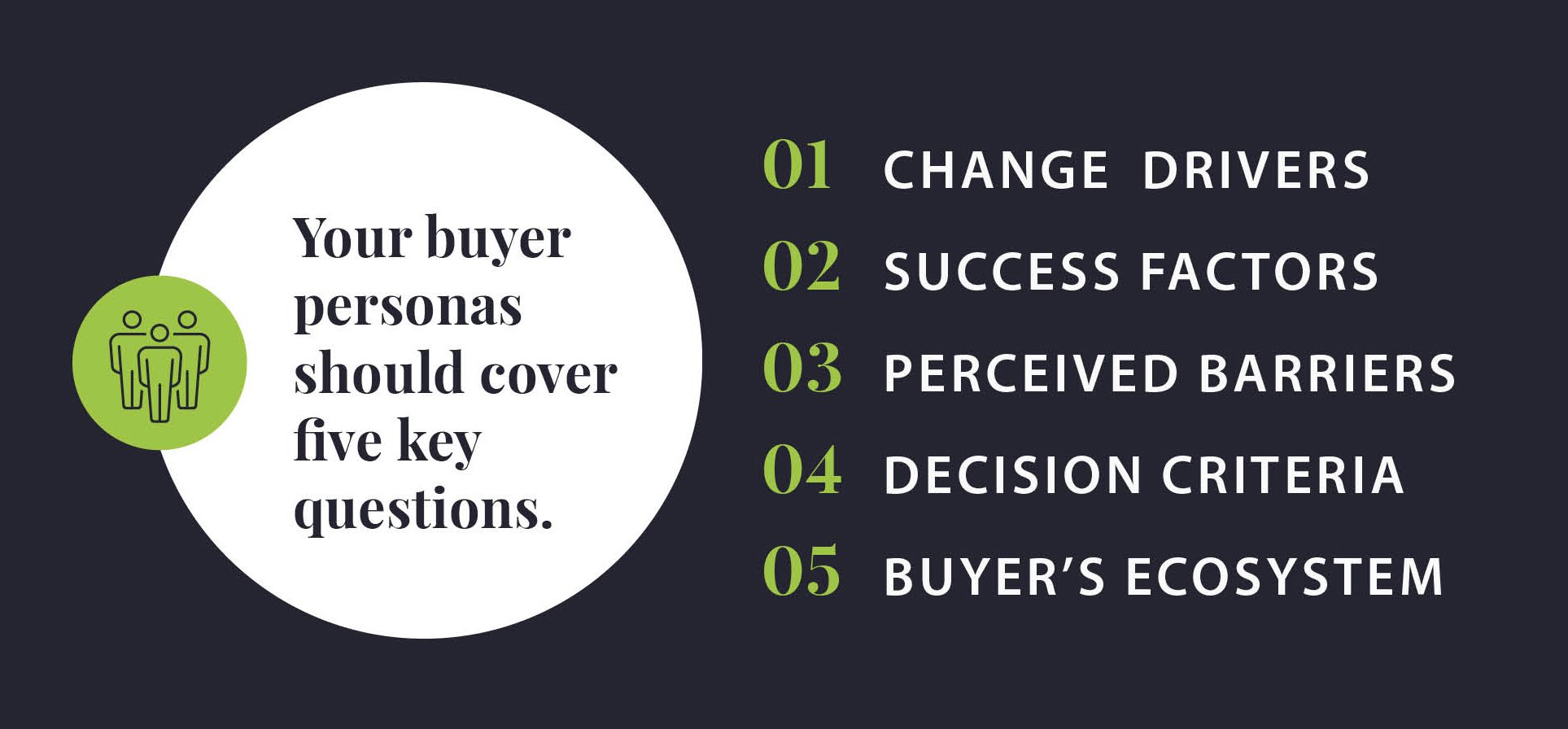Creating detailed buyer personas for your ideal customers is essential to a successful content strategy and can transform your growth plans. We explore how to develop a buyer persona profile for your contract manufacturing business.
Many contract manufacturers have an unsustainable pipeline because they’ve failed to differentiate themselves.
Most of those missing the mark with their messaging suffer from one significant oversight: they haven’t truly understood the buying agendas of their customers.
In other words, they haven’t documented their buyer personas.
But don’t just take our word for it.
Research shows that 71% of companies that exceed their revenue and lead goals have documented buyer personas. High-performing companies are also 2.3 times more likely to research the drivers of their personas than their competitors.
What are buyer personas?
Buyer personas are an in-depth representation of ideal customers. They go beyond the demographics of your target audience and represent attitudes, behaviours, challenges and aspirations.
Buyer personas should be detailed and comprehensive, covering things like:
- Demographics
- Job role and responsibilities
- Goals and aspirations
- Challenges and pain points
- Sources they go to for information
- Who and what influences them as they make decisions
Creating buyer personas is essential for contract manufacturers investing in a B2B marketing strategy and inbound marketing.
Why do buyer personas matter?
Inbound marketing aims to attract new prospects, generate new leads, convert them to customers and turn customers into evangelists for your business.
To do this well, you need buyer personas to help shape and form the content and the context required at each touch point throughout the buyer’s journey.
A good buyer persona helps answer questions like:
- What messages should I focus my content around?
- What questions do I need to be answering?
- What types of content should I create?
- Where should I share my content?
By creating content for inbound marketing that helps your ideal customers solve their problems, you can offer value before starting a sales conversation.
You could write two or three blog posts per week, but your efforts will be wasted if that content doesn’t speak directly to your ideal customers.
Buyer personas are also valuable in helping to:
- Shape marketing and sales strategies
- Align your sales and marketing teams
- Inform product/service development
How to develop buyer personas for manufacturing

To ensure your buyer personas positively impact your content creation, lead generation and sales, each B2B buyer persona should cover five key questions:
1. Change Drivers: What causes buyers to invest in solutions like yours, and what is different about buyers who are satisfied with the status quo?
2. Success Factors: What operational or personal results does your buyer persona expect to achieve by purchasing this solution?
3. Perceived Barriers: What concerns cause your buyer to believe your solution or company is not their best option?
4. Decision Criteria: Which aspects of the competing products, services, solutions or company does your buyer perceive as most critical, and what are their expectations for each?
5. Buyer’s Ecosystem: What is this buyer’s role in decision-making, and who and what else will impact it?
3 steps to developing your buyer personas
Developing your buyer personas involves 3 key steps:
- Run an internal workshop
- Interview customers
- Create buyer persona profiles
1. Run an internal workshop
Holding an internal workshop with your Marketing and Sales teams is an excellent place to start. Here you can scope out a top-level sketch of your personas based on existing knowledge, data and feedback.
Your Marketing team will have data on where your current online visitors are located and how they found your website, as well as details about their demographics, industry and job role. They may also have collected data from market research, such as customer satisfaction surveys.
Your Sales team will understand the types of customers your business attracts, what they want to achieve from investing in your service, and the common objections to purchasing.
Things to cover include:
- Name, age, gender
- Job title, description, what a typical day looks like
- Where they sit in the company structure - who do they report to, who reports to them?
- Their challenges, what keeps them up at night
- Why they might choose to do business with you
- The operational and personal results they want to achieve
- The concerns or objections they have about investing in your service or company (real or imagined)
- The factors that are most important to them when looking for a new service (e.g. price, support, features, company reputation)
- The online and offline sources they use to find out about services like yours
- Who else influences their decision
At the end of the workshop, you want to have developed a solid foundation for your personas.
2. Interview customers
Each buyer persona shouldn’t be built on internal knowledge and experiences alone. To truly understand your ideal customer, you need to speak to them.
Your existing customers are essential to speak to as they’ve already invested in your service and engaged with your company.
Speaking with prospects who have not purchased from your company is also a good idea. Use data in your CRM to identify who might fit your persona type. Consider also speaking to ‘closed-lost’ prospects who chose a competitor service over your own. They can tell you how they decided to choose them over you.
Speaking to your customers over the phone or via video is likely the easiest and most convenient option. But if you have local customers, speaking face-to-face at their workplace can be of real value as it will help you build a more robust picture of a day in their life.
Tips for interviewing customers:
- Have your questions ready
- Ask ‘why?’ - this should be your follow-up to almost every question you ask. Start with a broad issue, then spend time digging deeper.
- Record it
Once you have conducted your interviews, you can use what you’ve learned to build on the sketches you drew in the workshop. This will take time and may require further discussions as a team. Your personas may change a lot from your initial work, which is ok.
3. Create buyer persona profiles
Now you’ve gathered all this information, you can build comprehensive profiles for each buyer persona.
Your buyer personas should include the following elements:
- A catchy name, e.g. "Quality Clive" or "Procurement Pat"
- An image (you could use a stock photo or one of your real customers who typifies that persona)
- Real quotes to bring your personas to life and give insight into the language they use
- A detailed account of their demographics, role and responsibilities, and their values and pain points
- Their go-to sources for information about their industry, both online and offline
- A list of traits your Sales team can use to help identify personas when talking to prospects, e.g. “preference for email communication” or “likely to have an assistant screening calls”
- A detailed narrative of their Change Drivers, Success Factors, Perceived Barriers, Decision Criteria and Buyer’s Ecosystem
Once you’re happy with your buyer persona profiles, share them across the business, so everyone is on the same page. Your personas will quickly become part of your internal language.
How many buyer personas should you create?
While there’s no hard and fast rule for how many buyer personas you should create, it’s important you develop one for each of the main types of customers you sell to.
Even if you only offer one service, likely, you’ll still be selling to more than one type of customer. Decision makers in Procurement, Operations, Quality Assurance, and the C-suite may all be involved in the buying process.
Therefore, you’ll want to craft separate content for each of them that directly addresses their specific needs and priorities.
On average, manufacturing marketers create content for four different audiences, according to the CMI.
How often should you review your buyer personas?
Once you have created your personas, they should be regularly reviewed and updated. Your ideal customers’ needs are not static. They are subject to change; due to shifts in the economy, the introduction of new technologies, or changes to the organisational structure of their business.
Change may occur at your end too, with service alterations or expansion into new areas. In these circumstances, reviewing your buyer personas will be especially important.
Using buyer personas across the buyer's journey
So you’ve got your buyer persona profiles, now what?
Your Marketing team can use them to create content for your target customer and campaigns that make a difference. Your buyer personas illustrate your ideal customers' needs, interests, fears and aspirations. The profiles you create for each will be bursting with opportunities for content that will respond to those aspects.
Understanding the buyer's journey is essential for developing buyer personas because it provides crucial insight into your target audience's specific experiences, challenges, needs, and motivations at each stage of the buying process.
1. Awareness Stage: This is when the buyer realises they have a problem or a need. Understanding their concerns or motivations can help shape the persona at this stage. This can include what prompts them to seek a solution, their initial thoughts, and the emotions they experience during this phase.
2. Consideration Stage: The buyer actively searches for solutions to their problem. They consider different options, comparing brands, features, prices, etc. Understanding how your buyer persona researches and evaluates other options can help shape your marketing strategies. This could involve the channels they use, the information they value, and their decision-making criteria.
3. Decision Stage: At this stage, the buyer has decided on a solution category and is about to purchase. It is crucial to understand what can influence their final decision and what their preferences are for purchase, delivery, and post-purchase engagement.
The buyer's journey is not always linear. In some cases, buyers bounce back and forth between stages, especially in B2B markets where multiple decision-makers are involved. Therefore, it's crucial to take a flexible approach when developing buyer personas.
By integrating the buyer's journey into your buyer personas, you can:
-
Personalise your content and messaging to align with the needs and behaviours at each stage.
-
Address specific pain points and obstacles at the right time.
-
Position your service as the optimal solution.
-
Improve lead nurturing strategies and increase conversion rates.
Integrating the buyer's journey into your buyer personas gives you a more holistic and accurate picture of your target audience, allowing you to engage them more effectively and efficiently. You can learn more in our blog post: How to map content to the B2B buyer's journey.
Meanwhile, your customer persona profiles will help your Sales team target prospects and tailor conversations with them in a way that appeals to their motivations.
Summary
Knowing your audience is critical to your sales and digital marketing efforts. If you don’t know their world in intimate detail, you will fail to connect with them in a way that transforms your growth.
Buyer personas are helpful for creating a common language between your Sales and Marketing teams so you can attract, engage and convert leads into customers. And they are essential for a B2B marketer pursuing manufacturing marketing and content marketing success.
Editors note: This blog post was originally published in September 2017 and has been updated in 2022 for accuracy.


